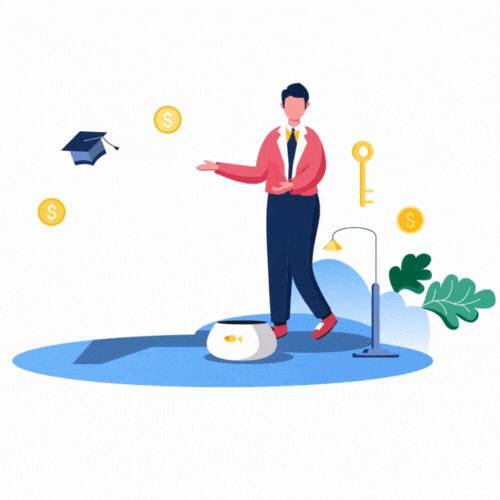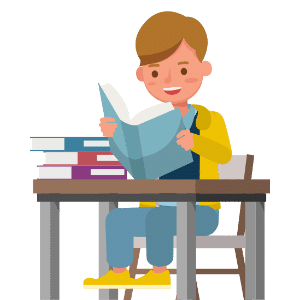
Theories about Reading
Educate, Empower, Excel
A single platform for teaching anything—online or offline.
Get Your Free AccountTheories about Reading: Scale up your reading skills with the reading theories and models
Educate, Empower, Excel
A single platform for teaching anything—online or offline.
Get Your Free AccountTheories about reading are the backbone of language learning. They provide educators with a framework for understanding how students learn and what teaching strategies are most effective.
One of the key benefits of using theories of reading is that they help teachers and parents tailor their instructional methods to the needs of their children. In addition, it can lead to increased engagement and better retention of information for all students.
Why should you Read?
It is undisputed that reading skills are a decisive factor for success in school, college and professional life. A study found that reading with children from an early age strongly correlates with brain activation in areas connected with visual imagery and understanding the meaning of language.
Reading is one of the most complex acts of the human mind: it involves everything from essential pattern recognition to complicated problem solving. Reading daily to young children, starting in infancy, can help with language acquisition and literacy skills
Reading theorists propound that good reading capability improves your academic score and ensures impeccable reading section training for language tests like IELTS and PTE .
How do we read?
There are many ways of reading the text. Your reading of a text depends on what the text is and the purpose of reading the text. For example, one reads a novel differently from the way one reads a coursebook on the fundamentals of physics. Whether you are a Grade 10 student, an undergraduate or a professional studying to upskill yourself, a reading strategy is indispensable for everyone.
There are various techniques for reading:
Text Preview
It entails that you get familiar with the text without reading it. Such a practice allows you to decide if the information is relevant, concentrate on essential sections and omit which are not. While previewing, look for the following:
- the title and author
- headings, subheadings, chapter summaries
- images, graphs, diagrams
- the opening sentence in each chapter
An abstract, if provided, is to be considered a part of the previewing activity.
Skimming
It involves moving your eyes over large chunks of text. You go through the paragraphs and pick out the main ideas without actually processing all the details given. You can finish a chapter quickly in this manner. To follow skimming while reading:
- pick out the text in bold/italics
- start from the first sentences and glide over the text quickly
- read a few words and not every line in a paragraph
Scanning
When you go through a text to look for specific information, it is termed scanning. Such a technique is a lifesaver when you go through vast data to locate the required text. To scan the text:
- after skimming, identify the text that you will have to read.
- go through the text to find the information
- when you reach the critical phrase or sentence, slow down and read it more thoroughly
Intensive Reading
You must practise it for detailed reading and studying relevant parts of a chapter or information. To read intensely:
- start from the first sentences, and underline any important words or phrases without disturbing your reading flow.
- re-read the text in case you found it difficult in the first reading.
- pay attention to the main idea in each paragraph. You may locate it in the first and or last sentence.
- review the new words and phrases you found while reading and search for their meanings.
- If you need help understanding their purpose, perhaps reading further will clarify their position in the text.

Major Reading Theories
Theories about reading have seen their phase of changes and transitions. The shift in pedagogies has given impetus to revising the reading theories and models.
The Traditional Theory
It deals with the readers acquiring a set of sub-skills that sequentially move towards building comprehension. As per this theory of reading, once the readers master these skills, they are considered experts who can understand what they read. Also called the ‘bottoms up’ view of reading, the features of this theory include:
- Readers anticipate the words as they read and get familiar with the letters.
- When the terms are identified, they get decoded into inner speech from which the reader derives meaning in the same way as listening.
The readers have to reproduce the importance of the text. It is also called the’ outside in’ approach, as the meaning is in the text, and the reader must interpret and assimilate it.
The Cognitive View or ‘top-down’ Approach
It is the opposite of the ‘bottom-up theory. The reading theory states that a reader’s cognitive and language competence is vital in constructing meaning from printed materials. They are based on the psycholinguistic interaction theory between thought and language.
- Readers read the text, sample it, make assumptions, confirm or reject them, make new assumptions, etc.
- Comprehension is obtained using only the necessary information from the graphic, syntactic, and semantic cue systems.
- Such a model is most appropriate for skilled readers at the advanced or more advanced level.
The Metacognitive View
The Metacognition approach is in vogue. As per this reading theory, reading involves thinking about what one does while reading. In this theory, it is stated that readers attempt the following when reading:
- Identify the purpose and form of the reading before reading.
- Think about the character and features of the form of the text.
- Project the author’s purpose for writing the text.
- Choosing, scanning, or reading in detail
- Make predictions about what will come next in the text based on prior knowledge, the information they have read, and conclusions from previous stages.
Schema View
Schema reading theory is about comprehension and how the reader stores and interprets information. The information doesn’t sit in our minds but instead interacts with whatever knowledge we already know.
- A learner’s background knowledge interacts with the reading task and plays a crucial role in deciphering a text.
- The schemata, or background knowledge, play a fundamental role in comprehending a text.
Difference between Theories of Reading and Literacy Theory
Many confuse theories about reading with literacy theory. These theories are distinct. Literacy encompasses more than reading and writing. It is one’s ability to use several core skills, namely decoding, comprehension, writing, and speaking. Literacy theory studies how people develop these skills through various means. It Is important for educators because children need literacy skills to learn correctly, and adults with low literacy rates often struggle economically.
Theories of reading specifically relate to the advancement of reading and comprehension abilities in learners.
The theories of Reading and their Implication to the Teaching of Reading
The reading theorists have led the evolution of teaching English in classrooms. Each reading theory has affected teaching and learning styles.
Bottom-Up Approach
The most popular method associated with the bottom-up approach to reading is phonics awareness. It requires the learner to match letters with sounds in a defined sequence.
Phonics emphasise the need for readers to have repetition and understand that letters have sounds. Therefore, reading is a word-recognition response to the stimuli of printed words.
These lower-level skills rely on the visual stimulus or print and are consequently concerned with recognising and recalling.
Like the audio-lingual teaching method, phonics emphasises repetition and drills using the sounds that make up words.
Top-down theory
It portrays reading in a more positive light and sees it as an active task that requires intention from the participant.
There are challenges in applying this reading theory as it is hard for students to make predictions for a text that students don’t know. Reading is not just understanding the meaning of a text but relating information in the text with the knowledge the reader already has gained. In this sense, reading is a conversation between the reader and the text, an active cognitive process in which the reader’s previous knowledge plays a key role. Reading is purposeful and rational. Reading relies on the prior knowledge and expectations of the reader.
Metacognition Approach
The Metacognition theory, among all the reading theories and models, eliminates the debate of whether reading is top-down or bottom-up because the metacognitive view shows us that reading involves many processes besides making a hypothesis.
This reading theory can sometimes lead to poor reading comprehension because students aren’t making proper connections to the text. Metacognitive view is more about the before-reading process for a participant. It’s about skimming the text, looking for clues and thinking about what the purpose of the text may be about
Before the actual reading act on a text starts, some points should be considered to make the reading process more understandable. First, teachers should ensure that the words and grammatical structures in the texts to read are familiar to the learners.
The activities carried out during the during-reading stage include taking notes, reacting, predicting, selecting important information, questioning the writer’s position, evaluating, and placing a text within one’s own experience.
Schema View
The Schema theory is excellent for helping ESL students become better readers because it combines their background knowledge with the text provided. The reading theory of Schema states that we all carry different schemas so that the information can be available to every individual. Schema helps us find our memory and reconstruct new details when we read, thus enabling us to build more bridges in our brains.
Since the reader plays a fundamental role in constructing meaning, his age, gender, experience, and culture are vital considerations for teachers who want to select readings that will motivate their students.
The teacher’s role in activating and building schemata is paramount. To achieve it, he should select texts relevant to the student’s needs, preferences, individual differences, and cultures to provide meaningful readers, so the students understand the message, which entails activating existing schemata and helping build new one’s schemata.
Five Stages of Literacy Development
Reading development is the process of learning words, sounds, and language. The stages of literacy development can vary depending on the child’s fundamental concepts.
Stage 1: Literacy (4-6 years)
The child begins to understand letters and words. In this stage, the child will show the following behaviours:
- able to recognise the first letter of their names
- recognise some letters and their sounds
- singing the alphabet song
Stage 2: Alphabet FLuency (6-7 years old)
The child moves to the next stage, where they are comfortable with small words. Their behaviour includes:
- Finger-pointing to terms while reading
- Beginning to recognise words
- sing pictures and context clues to figure out certain words.
- Reading out loud word by word.
Stage 3: Words and Patterns ( 7-9 years old)
The children begin to develop more vital reading skills and may adopt behaviours in multiple stages of literacy development.
Their behaviour includes:
- more vital ability to comprehend reading materials.
- More self-correction
- easier time grouping letters.
- Able to recognise words that often come with reading
- Beginning to spell complex consonant words like “-tch”.
Stage 4: Intermediate Reading ( 9-11 years old)
Children begin to rely less on others to teach them words. As a result, they start writing their sentences with fewer errors and develop stronger fluency.
Some Behaviours of Stage 4 Learners:
- reading to learn new information and explore new concepts
- with less difficulty with independent reading.
- reading extended materials with little problem.
- An interest in learning and developing new vocabulary.
Stage 5: Advanced Reading (11-14 years old)
Children become fully fluent and can read to learn new concepts. Reading and writing are not challenging, and students can absorb complex reading materials without much effort.
Some Behaviours of learners include
- the desire to read numerous types of reading materials.
- the ability to create longer texts such as essays or book reports.
- readers have a strong understanding of the words and their meanings.
- the ability to grasp and retain complex reading materials.
Each stage of literacy development provides unique challenges and achievements in advancing reading and writing skills.
Strategies to improve reading among children
Developing reading comprehension skills is incredibly important for early readers, starting as early as picture books. Then, as school-aged children age, it will help them understand textbooks, newspapers, and other more complex texts.
Read Aloud
Encouraging children to read aloud improves their pronunciation and makes them slow down while reading. Consequently, they pay attention to words and try to understand their meanings in the context of the text.
Planning the Reading Material
Resources like books should be kept handy based on the child’s previous knowledge, age and grade level. A child must be able to read most of the words when given a reading task.
Discuss the reading material
Ask questions before, during and after the reading “why do you want to read this book?” “what is happening in the story?” What did you like about the book?” This technique allows them to think about what they have read and even relate the text’s theme to their experience.
Create A Routine
Develop a schedule for the child so that the reading occurs daily. As a result, an independent reading habit develops, and the child feels motivated to read.
Conclusion
Reading is an essential building block for language learning. Theories of reading are crucial in language development because they provide a comprehensive understanding of how reading skills are acquired and how language is processed.
Step Up Your Teaching Game Today!
Sign-up for a personalised dashboard, teaching tools, and unlimited possibilities!

Frequently Asked Questions
The three major reading theories are:
- Traditional theory
- Cognitive theory
- Metacognitive theory
The stages of the Model of Reading are:
Emergent Literacy
Alphabetic Fluency
Words and Patterns
Intermediate Reading
Advanced Reading
Emergent Literacy: (4-6 years): the child begins to understand letters and words. In this stage, the child will show the following behaviours:
- able to recognise the first letter of their names
- recognise some letters and their sounds
- singing the alphabet song
Classical conditioning theory declares that behaviours are learned by connecting a neutral stimulus with a positive one. The learned behaviour is called a conditioned response.
It deals with the readers acquiring a set of sub-skills that sequentially move towards building comprehension. Once the readers master these skills, they are considered experts who can understand what they read. Also called the ‘bottoms up’ view of reading, the features of this theory include:
- Readers anticipate the words as they read and get familiar with the letters.
- When the terms are identified, they get decoded into inner speech from which the reader derives meaning in the same way as listening.
The readers have to reproduce the importance of the text. It is also called the’ outside in’ approach, as the meaning is in the text, and the reader must interpret and assimilate it.
It is the opposite of the ‘bottom-up theory. The reader’s cognitive and language competence is vital in constructing meaning from printed materials. They are based on the psycholinguistic interaction theory between thought and language.
- Readers read the text, sample it, make assumptions, confirm or reject them, make new assumptions, etc.
- Comprehension is obtained using only the necessary information from the graphic, syntactic, and semantic cue systems.
- Such a model is most appropriate for skilled readers at the advanced or more advanced level.
The Metacognition approach is in vogue. It involves thinking about what one is doing while reading. In this theory, it is stated that readers attempt the following when reading:
- Identify the purpose and form of the reading before reading.
- Think about the character and features of the form of the text.
- Project the author’s purpose for writing the text.
- Choosing, scanning, or reading in detail
- Make predictions about what will come next in the text based on prior knowledge, the information they have read, and conclusions from previous stages.

